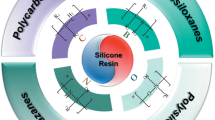Abstract
Preparation and characterization of weather resistant silicone/acrylic resin coatings were conducted. In order to prepare these coatings, a silicone/acrylic resin (KLD) was first prepared by an addition polymerization reaction of monomers, including n-butyl acrylate, methyl methacrylate, n-butyl methacrylate, and 3-methacryloxypropyltrimethoxysilane (MPTS). In the preparation of the silicone/acrylic resin, Tg of the acrylic copolymer was fixed at 40°C and the contents of MPTS were varied to be 10, 20, and 30 wt%. The weather resistant silicone/acrylic resin coatings were then prepared by blending the synthesized silicone/acrylic resin and TiO2. The viscosity of the synthesized resin decreased with the content of MPTS, whereas the thermal stability at high temperature increased. The prepared coatings exhibited excellent adhesion to various substrates, and various physical properties of the coatings were satisfactory. The weatherability of the coatings was tested three ways: outdoor exposure test, Weather-Ometer (WOM), and QUV accelerated weatherability tester (QUV). The gloss retention, yellowness index difference, color difference, and lightness index difference were improved at high MPTS concentration. The coatings containing 30 wt% MPTS have especially good weather properties.
Similar content being viewed by others
References
Tsubouchi, K., “Degradation and Stabilization of Polymer Coatings,”J. Jpn. Col. Material, 59, 272 (1986).
Nakamichi, T., Sakurai, F., and Okamoto, S., “Weatherability of High Solids Coating Films,”J. Jpn Col. Material, 60, 519 (1987).
Endo, T.,Development and Applications of New Reactive Monomers, pp. 156–168, CMC Co. Ltd., Tokyo, 1993.
Rao, V.L. and Babu, G.N., “Copolymerization of Methyl-Alpha-Bromoacrylate, 2-Bromoethyl Methacrylate and 2,3-Dibromopropyl Methacrylate Vinyltriacetoxy Silane,”Eur. Polym. J., 26, 227 (1990).
Yasuyuki, F., Masakazu, I., Akira, Y., and Naoki, Y., “Synthesis and Morphology Analysis Silicone/Acryl Compound Rubbers,”J. Polym. Sci. Technol., 50, 391 (1993).
Witucki, G.L., “A Silane Primer; Chemistry and Application of Alkoxy Silanes,”Journal of Coatings Technology,65, No. 822, 57 (1993).
Kanegafuchi Kagaku Kogyo Co., “Curable Composition at Room Temperature,” U.S. Patent 4,975,488 (1990).
Kanegafuchi Kagaku Kogyo Co., “Curable Composition Suitable as Top Coat and Coated Material Using the Same,” U.S. Patent 5,891,958 (1999).
E.I. DuPont Co., “Coating Composition of an Acrylic Polymer, a Crosslinking Agent and a Silane Oligomer,” U.S. Patent 5,066,698 (1991).
PPG Industries, Inc., “Ambient Temperature, Moisture-Curable Acrylic-Silane Coating Composition Having Improved Pot Life,” U.S. Patent 4,043,953 (1977).
KS M 5000-2121, “Testing Method of Viscosity for Transparent Liquids,” Korea Industrial Standard Test Method, issued in 1990.
KS M 5000-4012, “Color Examination Method of Resins for Coating Materials,” Korea Industrial Standard Test Method, issued in 1990.
KS M 5000-2113, “Testing Method of Volatile and Nonvolatile Content for Paint, Varnish, Lacquer, and Related Materials,” Korea Industrial Standard Test Method, issued in 1990.
KS M 5000-1111, “Preparation of Steel Panels for Organic Coating Materials,” Korea Industrial Standard Test Method, issued in 1990.
KS M 5000-1112, “Method of Made for Tin Panel for Use in Paint, Varnish, Lacquer, and Related Materials,” Korea Industrial Standard Test Method, issued in 1990.
KS M 5000-1121, “Method of Made for Glass Panel for Use in Paint, Varnish, Lacquer and Related Materials,” Korea Industrial Standard Test Method, issued in 1990.
KS M 5000-3241, “Testing Method for Weathering Resistance of Paint,” Korea Industrial Standard Test Method, issued in 1990.
KS M 5000-3231, “Testing Method for Accelerated Weathering,” Korea Industrial Standard Test Method, issued in 1989.
Kobayashi, M., “Study on the Sequence Distribution and Glass Transition Temperature of Acrylic Resin for Industrial Paints (III),”J. Jpn. Col. Material, 56, 518 (1983).
Groele, R.J. and Rodriguez, F., “Dissolution Rate of Polymers and Copolymer Based on Methyl, Ethyl and Butyl Methacrylate,”Journal of Coatings Technology,61, No. 774, 55 (1989).
Teashima, H. and Isozaki, O., “A New Room-Temperature Curing System,”J. Oil & Colour Chem. Assoc., 75, 222 (1992).
Kim, S.K., “Synthesis of Modified 3-Methacryloxypropyltrimethoxysilane Acrylic Resins and Their Physical Properties as Super-Weatherable Coatings,” Ph.D. Dissertation, Myongji Univ., Yongin, Korea, 1998.
Paul, S., “Pyrolysis Gas Chromatographic Analysis of Methyl Methacrylate-Ethyl Acrylate Copolymers,”Journal of Coatings Tehnology,52, No. 661, 47 (1980).
Finzel, W.A., “Film Erosion Studies of Silicone-Modified Copolymer Paints,”Journal of Coatings Technology,52, 660, 55 (1980).
Park, H.S., Keun, J.H., and Lee, K.S., “Synthesis and Physical Properties of Two-Component Polyurethane Flame-Retardant Coatings Using Chlorine-Containing Modified Polyesters,”J. Polym. Sci. (Part A), 34, 1455 (1996).
Park, H.S., Ha, K,J., Keun, J.H., and Kim, T.O., “Preparation and Physical Properties of Two-Component Polyurethane Flame-Retardant Coatings Using Trichloro Modified Polyesters,”J. Appl. Polym. Sci., 70, 913 (1998).
Calbo, L.J.,Handbook of Coatings Additives, Marcel Dekker, Inc., pp. 307–356, New York, 1992.
Mayer, H., “Masonry Protection with Silanes, Siloxanes and Silicone Resin,”J. Oil & Colour Chem. Assoc., 81, 89 (1998).
Szbo, A. and Hencsei, P., “The Effect Modified Silicone Copolymers on Surface Tension,”J. Oil & Colour Chem. Assoc., 81, 135 (1998).
Kinoshita, K., Tsubota, M., and Ikemoto, E., “Introduction to Understand Physical Properties of Coatings (VII): The Strength of Paint Film and Its Wether Resistance,”J. Jpn. Col. Material, 69, 45 (1996).
Author information
Authors and Affiliations
Additional information
Dept. of Chem. Eng., Yongin 449-728, Korea.
Ansan 425-110, Korea.
Rights and permissions
About this article
Cite this article
Park, H.S., Kim, S.R., Park, H.J. et al. Preparation and characterization of weather resistant silicone/acrylic resin coatings. Journal of Coatings Technology 75, 55–64 (2003). https://doi.org/10.1007/BF02697923
Issue Date:
DOI: https://doi.org/10.1007/BF02697923




